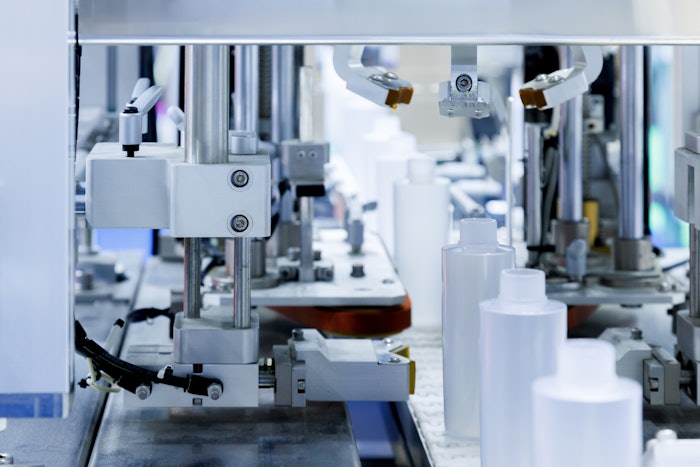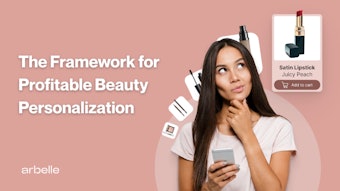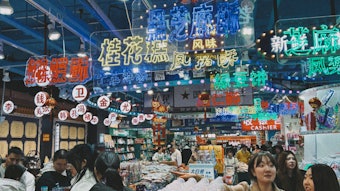
The beauty industry is facing unprecedented challenges due to geopolitical instability and rising costs. Trade conflicts, supply chain disruptions, and inflation are forcing brands to adapt and find new ways to control costs while maintaining competitiveness.
To mitigate these challenges, companies are diversifying supply chains, implementing cost-control strategies like order consolidation and embracing technology like predictive analytics. Sustainability is increasingly intertwined with cost control, with brands prioritizing eco-friendly practices to reduce their environmental impact and enhance their brand image.
Sustainability and Cost Control: A Synergistic Approach
 Jonathan Regev, vice president worldwide sales and business development, Jojoba DesertJojoba Desert
Jonathan Regev, vice president worldwide sales and business development, Jojoba DesertJojoba Desert
Regev adds, “One key strategy we’ve implemented is encouraging our customers to consolidate their orders into larger, less frequent shipments and to opt for bulk containers instead of smaller-sized packaging. This approach not only reduces transportation costs - an increasingly significant factor in today’s volatile market - but also aligns with our shared commitment to sustainability by minimizing packaging waste and lowering the carbon footprint associated with shipping.”
 Akemi Ooka, vice president of supply chain and sustainability resources for the Independent Beauty Association (IBA)Independent Beauty Association (IBA)
Akemi Ooka, vice president of supply chain and sustainability resources for the Independent Beauty Association (IBA)Independent Beauty Association (IBA)
Ooka adds, “This reduces the need to carry lesser performing goods and associated raw and pack items in inventory, lowering complexity across the supply chain. I’m not sure that brands are increasing prices on the shelf ahead of future instability—that is often difficult to establish with retailers or consumers. In truth, brands have been dealing with higher costs for some time now, and many have already had to increase prices to relieve margin pressure or ensure supply. I anticipate that if costs rise again and cannot be offset, there may be additional price increases on the shelf.”
Predictive Analytics and Supply Chain Resilience
Regev emphasizes the role of technology in navigating these challenges, stating, “Technology and data analytics are essential tools in navigating this uncertainty. Jojoba Desert leveraged predictive analytics to better forecast demand and optimize production cycles. This not only ensures our supply chains remain resilient and efficient, even in the face of global disruptions, but also helps us preserve the freshness of our products by aligning production closely with demand. Moreover, these tools enable us to maintain the exceptional quality and value our customers have come to expect.”
She adds, “Transparency remains at the heart of our efforts. By openly communicating these strategies to our customers, we demonstrate how these adjustments not only help manage costs but also align with broader sustainability goals. These proactive steps reflect our commitment to building long-term resilience and delivering value, no matter the challenges we face.”
Cost of Raw Materials and Finished Goods
Ooka says, “Instability is always a major concern for businesses, and one of the biggest uncertainties today is the threat of tariffs on imported materials, particularly from China. There are a number of raw and pack materials that are sourced from China, along with various chemical intermediates that aren’t produced elsewhere, and a trade conflict could not only affect prices but overall availability of goods or materials, regardless of price.”
She adds, “What is also unclear is how the weakening consumer market in China will continue to play out in 2025—while supply is being focused more on domestic Chinese demand, excess material could still flood global markets, offsetting price increases from inflation or tariffs (though this may lead to further trade tension overall). It is quite uncertain what geopolitical developments will arise in the new year, but anything that disrupts global supply chains often has longstanding effects, particularly for specialty materials that cannot be easily replaced.”
 Dan Wolfe, senior vice president of business development at CosmopakCosmopak
Dan Wolfe, senior vice president of business development at CosmopakCosmopak
Wolfe adds, “To address rising costs while maintaining competitiveness, brands are adapting pricing strategies with greater transparency, communicating price changes alongside their commitment to quality and sustainability.”
He concludes, “Cost engineering and value delivery remain pivotal. At Cosmopak, we implement development strategies to execute the highest quality products that are commercially viable for our clients. Our sales and development team always works with cost targets in mind, while on an operational front we optimize supply chain efficiency, streamline production processes, and reduce waste. Combined, these drive both cost reduction and sustainability goals.”
Ooka adds, “Brands are looking to sources outside of China to ensure secondary supply—they have been doing this since the post-Covid supply crisis. Interestingly, some of the post-Covid manufacturing investments by suppliers are now starting to come online in areas like Southeast Asia and Mexico, so there are options for brands to test and build secondary supply lanes. There is also interesting innovation in biotech-based raws, and those are less tied to a geographic area, which may create opportunities to establish manufacturing and supply in less volatile areas and with a much smaller footprint or shorter supply chains.”
 Alexandria Scoffell, brand manager at Kevyn Aucoin BeautyKevyn Aucoin Beauty
Alexandria Scoffell, brand manager at Kevyn Aucoin BeautyKevyn Aucoin Beauty
Scofell adds, “Additionally, when budgets tighten, people become more selective, embracing the philosophy of ‘quality over quantity.’ This shift mirrors trends in fashion, where consumers are gravitating toward durable, high-quality clothing—or even thrifted items—that stand the test of time, rather than fast fashion that quickly loses its appeal. While makeup can’t be thrifted, the same principle applies: buying fewer, versatile products that form the foundation of a ‘capsule wardrobe’ for beauty – products that are reliable, interchangeable, and suitable for any occasion.”
She concludes, “Beyond practicality, prestige brands like Kevyn Aucoin Beauty offer an emotional connection. When customers purchase from an artistry-led brand, they’re not just buying makeup, they’re investing in an experience, a story, and a connection to something empowering and aspirational.”
Wolfe says, “Consumer trust plays a critical role in today’s market. Brands are increasingly transparent about their efforts to manage costs responsibly and sustainably. By highlighting initiatives such as sustainable packaging, eco-friendly materials, and ethical production practices, brands can reinforce their commitment to delivering value while aligning with consumer expectations for responsible business practices.”
Trade Conflicts and Global Considerations
 Nick Ignazzi, operations director, Provital USAProvital USA
Nick Ignazzi, operations director, Provital USAProvital USA
Ignazzi adds, “To cope, brands are diversifying supply chains, essentially hedging their bets, and partnering with reliable suppliers. Some are localizing production or stockpiling raw materials like they’re prepping for a beauty apocalypse. It’s all about finding ways to keep the glow without the chaos. Shrinkflation, higher prices, and eating costs are all in play. The boldest brands eat the costs, hoping loyalty will outlast any turbulence. But honestly, adapting to trade disruptions feels like styling hair in a wind tunnel…creative, necessary, and absolutely unpredictable.”
Value Delivery
In the cosmetics industry, "value delivery" encompasses more than just the product itself. It includes a combination of factors such as superior product performance, a strong brand story, a positive customer experience, ethical sourcing practices, and a commitment to sustainability. Brands that successfully deliver value create a strong emotional connection with consumers, fostering loyalty and driving long-term success.
 Nina Esposito, marketing director, Provital USAProvital USA
Nina Esposito, marketing director, Provital USAProvital USA
Esposito adds, “Add a dash of sustainability storytelling, a sprinkle of transparent pricing, and a solid foundation of educational campaigns, and you’ve got a recipe for consumer love. With eco-chic packaging, carbon-neutral vibes, and streamlined formulations, brands are proving that affordability doesn’t have to skimp on innovation or integrity—it’s simply skin care smarter, not harder.”
Ooka says, “The highest impact cost savings are often cross-functional team endeavors, as they often require secondary qualification and testing. This means it is best to get ahead of supply chain vulnerabilities so product and manufacturing teams can formulate and test with alternate materials if needed. It is also important to have solid communication with suppliers and manufacturers so that they understand your demand and can help you manage inventory, timelines, and cost of goods. There may also be options like payment term negotiations or blanket PO strategies that allow for more procurement flexibility and responsiveness across the supply chain.”
AI’s Influence on the Beauty Industry
From personalized product recommendations and virtual try-on experiences to accelerating ingredient discovery and optimizing supply chains, AI is transforming how brands interact with consumers and develop new products. This technology is enabling hyper-personalization, enhancing the customer experience, and driving innovation across the entire beauty ecosystem.
Ooka says, “AI is showing up in procurement vis a vis RFPs (both drafting and analyzing), and it is being used in demand planning and logistics as well. I anticipate it will continue to be a resource growing in importance and influence in the year to come. That said, AI data and processes should always be validated, as the information is only as good as the input data, and it can be difficult to know where the source data originates (and thus how accurate it is). There is also some utility in AI for formulation development, as it is being used this way in food, though I think this is slower to be adopted in personal care and cosmetics.”
Esposito concludes, “Meanwhile, AI is the industry’s fairy godmother, conjuring up trend-savvy formulations, lightning-fast launches, and digital crystal balls for ingredient tracking and transparency. Virtual testing steps in as the cost-slashing skin care guru, ensuring every product is trial-approved without breaking the budget.”
How Brands Can Navigate Uncharted Waters in the Beauty Industry
To thrive, brands must prioritize a multi-pronged approach. This includes diversifying supply chains, embracing technology like AI and predictive analytics for cost optimization and demand forecasting, and implementing innovative cost-control strategies like order consolidation and sustainable packaging. By focusing on delivering value through high-quality, innovative, and sustainable products while maintaining transparency with consumers, beauty brands can build resilience, navigate uncertainty, and continue to thrive in this dynamic market.














